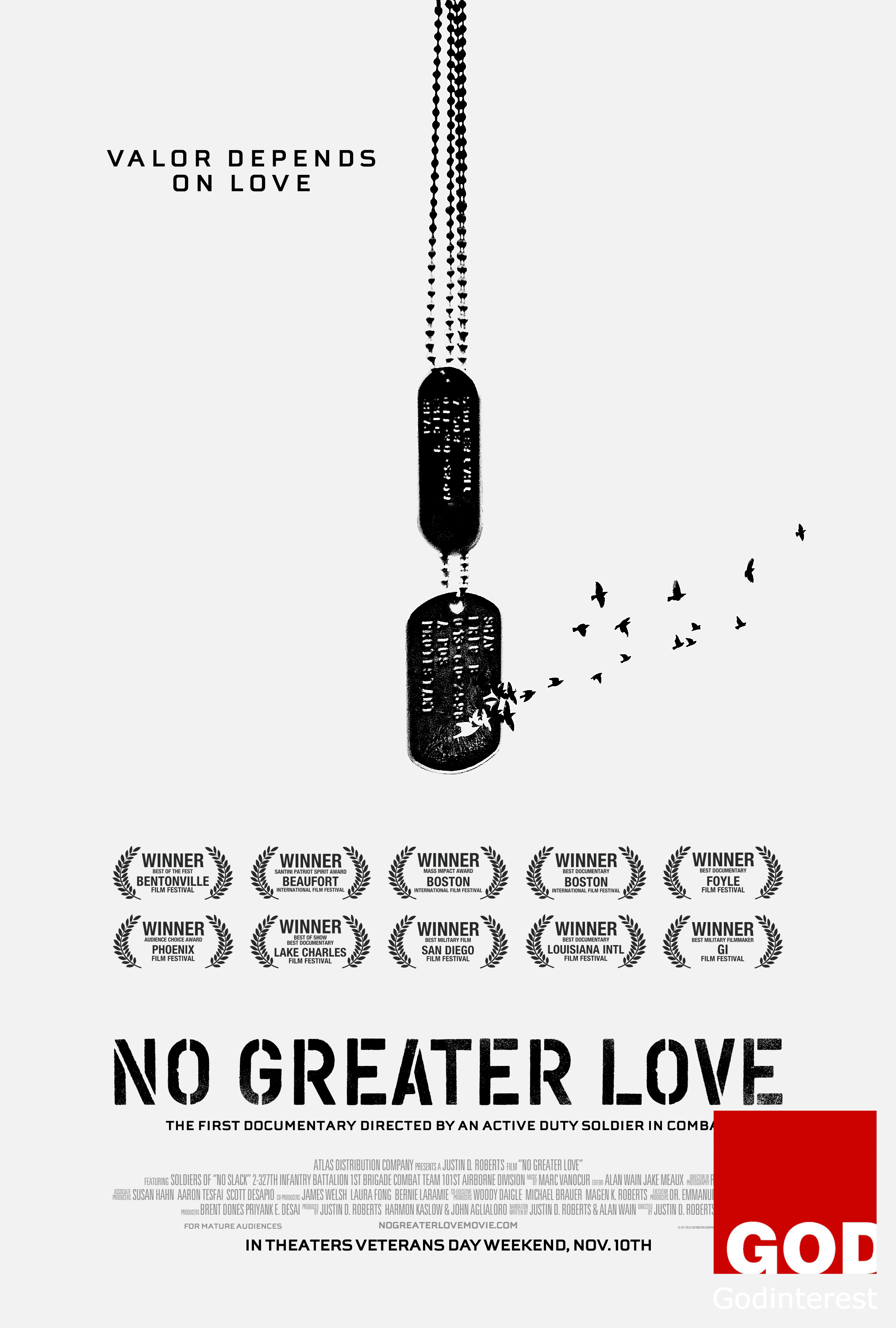LOS ANGELES – Nov. 2017 – NO GREATER LOVE—the first theatrical documentary filmed and directed by an active-duty soldier—brings to vivid life the battles of the “No Slack” Battalion (of the famed 101st Airborne Division) in Afghanistan . . . and back home.
Friday, Nov. 10, for Veterans Day weekend, the multiple-award-winning NO GREATER LOVE premieres in select cities nationwide. (For current theaters and to request local showings, check the website.) NO GREATER LOVE, after one round of cuts, is still a contender for Documentary Feature in the 2017 Academy Award ®.
REQUEST THEATERS TO SHOW NO GREATER LOVE IN YOUR AREA
“NO GREATER LOVE shows No Slack’s most intense firefights since Vietnam,” said former Army Chaplain Justin Roberts, who directed and filmed in Afghanistan for more than three years. “But it’s the stories behind the video that changed my life. How can soldiers who know this kind of danger, hardship and loss, transition back to civilian life? Home becomes a whole new battleground.”
Consider that:
- Every day, 20 U.S. military veterans commit suicide (Suicide Data Report, Department of Veteran Affairs, Mental Health Services, 2015)
- 20 percent of veterans suffer PTSD (Litz BT, Schlenger WE. PTSD in service members and new veterans of the Iraq and Afghanistan wars: a bibliography and critique. PTSD Res Q 2009;20(1):1-2.)
- Among incarcerated adults, 10 percent served previously in the military (Blodgett JC, Avoundjian T, Finlay AK, et al. Prevalence of mental health disorders among justice-involved veterans. Epidemiol Rev 2015;37. 000–000.)
- Of the U.S. homeless population, 12 percent are veterans (Tsai J, Rosenheck RA. Risk factors for homelessness among US veterans. Epidemiol Rev 2015;37. 000–000.)
Most Americans are unaware that U.S. military chaplains carry no weapons, even in battle—and it’s true that while deployed in Afghanistan, Roberts initially had no plans to make a film. The courage around him, however, spurred him to ask: “What drives men to commit acts of valor and sacrifice?” (As “No Slack” won decisive, strategic victories in intense battles, it also suffered multiple fatalities, returning home with more than 200 purple hearts.) Roberts also interviews Gold Star family members.
“The only way a person can really come back from war is with love,” Roberts said. “And it has to come from friends. It has to come from family members, neighbors and the people you were fighting for, and from each other. That is the only way we can fully come home.”
NO GREATER LOVE producers want the film to motivate theatergoers to get involved and support veterans in their local area.
GIVE TO LOCAL ORGANIZATIONS SUPPORTING VETERANS
Distributed by Atlas Distribution Company, NO GREATER LOVE has won 11 awards to date, including Best Documentary at the Boston Film Festival and the Louisiana Film Festival.
Awards
- No Greater Love has won 11 awards including:
- Best Military Filmmaker, GI Film Festival
- Santini Patriot Spirit Award, Beaufort Film Festival
- Best of Fest, Bentonville Film Festival
- Best Military Film, San Diego Film Festival
- Impact Award, Boston Film Festival
- Best Documentary, Boston Film Festival
- Audience Choice Award, Phoenix Film Festival
- Best Documentary, Foyle Film Festival (UK)
- Best Documentary, Louisiana Film Festival
- Best of Festival, Lake Charles Film Festival
- Best Documentary, Lake Charles Film Festival
Quotes
“No Greater Love cuts to the heart of why our warriors serve and needs to be seen by every American.” – General Stanley McCrystal
“The brotherly love of soldiers on the battlefield needs to be a part of their arsenal for the battles to come, far from the combat zone.” – The Leaf Chronicle
“The only solution lies in being able to connect veterans at the local community level.” – Army Times
“No Greater Love is a documentary composed of real footage captured by Roberts in Afghanistan that shows what it is truly like to be at war.” – Stephenville Empire Tribune
“When it seemed the traumatized battalion should be at a low point, the unit began to bond looking out for and talking to each other.” – The Leaf Chronicle

























